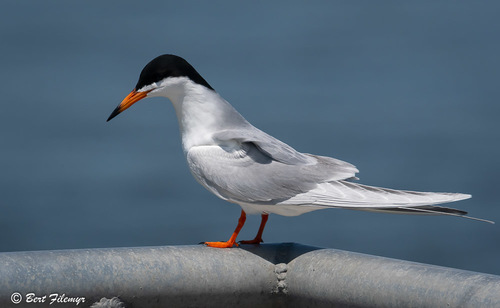
Forster's Tern
Forster's Tern (*Sterna forsteri*) is a graceful seabird known for its slender build, distinctive black cap during breeding season, and expert fishing skills. It plays a vital role in coastal and wetland ecosystems as a predator of small fish and invertebrates. This species is primarily found in North America, and while not globally threatened, it faces localized conservation challenges. It is named after the German naturalist Johann Reinhold Forster.
33-36 cm
Length
73-82 cm
Wingspan
Least Concern
Conservation Status
Distribution
Primarily found in North America. Breeds in interior marshes and along the Atlantic and Gulf coasts. Winters along the Pacific coast from British Columbia south to Mexico and Guatemala, and along the Atlantic and Gulf coasts from New Jersey south to the Caribbean and Central America. Migratory routes follow coastlines and major river systems.
Lifespan
The oldest recorded Forster's Tern was at least 24 years old.
Forster's Tern's Habitat
Habitat Types
Coastal marshes, Salt marshes, Estuaries, Freshwater marshes, Lakes, Reservoirs
Climate Zones
Temperate, Subtropical
Adaptations
Excellent vision for spotting prey from the air. Streamlined body and forked tail aid in agile flight and maneuverability while diving for fish.
Variations
No recognized subspecies, but there can be slight variations in size and plumage between eastern and western populations.
Appearance
Breeding Plumage
Breeding adults have a black cap, orange-red bill with a black tip, and orange-red legs. Non-breeding adults lose the black cap, retaining a black patch through the eye, and the bill becomes duller.
Seasonal Feather Changes
The most significant change is the appearance and disappearance of the black cap between breeding and non-breeding seasons.
Sex Based Plumage Differences
Males and females have similar plumage.
Notable Features
Long, pointed wings, Deeply forked tail, Black cap during breeding season, Orange-red bill with black tip (breeding)
Diet and Feeding
Primary Foods
Small fish, Crustaceans, Insects
Foraging Behavior
Primarily hunts by plunge-diving into water from the air. Also catches insects in flight or picks prey from the water's surface.
Specializations
Excellent vision and flight control allow for precise targeting and capture of prey.
Seasonal Diet Variations
Diet may shift slightly depending on prey availability. During breeding season, fish often make up a larger portion of the diet, while insects may be more important during migration or winter.
Behavior
Social Structure
Highly colonial during breeding season, forming colonies that can number hundreds or even thousands of pairs. Outside of breeding, may be found in smaller flocks.
Communication
Variety of calls, including a harsh 'kyarr' and a rapid 'kik-kik-kik', Visual displays, such as head-tossing and bowing
Migration
Migratory, traveling between breeding grounds in North America and wintering areas along the coasts of North and Central America.
Territorial or Group Behaviors
Highly territorial around the nest site, aggressively defending against intruders. Forages in loose flocks, often with other tern species.
Conservation
Threats
Habitat loss and degradation (due to coastal development, wetland drainage, and pollution), Human disturbance at breeding colonies, Climate change (sea-level rise, increased storm frequency), Predation (by gulls, rats, and other predators), Contaminants (e.g., pesticides, heavy metals)
Protection Programs
Habitat restoration and protection projects, Monitoring of breeding colonies, Public education and outreach
Local National Laws
Protected under the Migratory Bird Treaty Act in the United States and Canada.
Population Trend
Stable
Population Estimates
The global population is estimated to be around 140,000 mature individuals.
Interesting Facts
They are known for their aggressive defense of their nesting colonies.
Forster's Terns will dive-bomb intruders, including humans, that approach too close to their nests or young.
They can sometimes be confused with other tern species, especially the Common Tern.
Careful observation of bill color, cap extent, and call can help distinguish them.
Their flight is buoyant and graceful, often described as 'dancing' on the wind.
This elegant flight style helps them conserve energy while searching for prey.
Faqs about Forster's Tern
What is the difference between Forster's Tern and Common Tern?
Forster's Terns have an orange-red bill with a black tip during breeding season, while Common Terns have a red bill that may or may not have a black tip. Forster's Terns also have a slightly more deeply forked tail and a different call.
Where can I see Forster's Terns?
Look for them along coastlines, in marshes, and near lakes and reservoirs in North America. Check local birdwatching guides for specific locations and times of year.
Are Forster's Terns endangered?
No, they are currently classified as Least Concern by the IUCN. However, they face localized threats and their populations should be monitored.
Copyright @ Nature Style Limited. All Rights Reserved.
 English
English